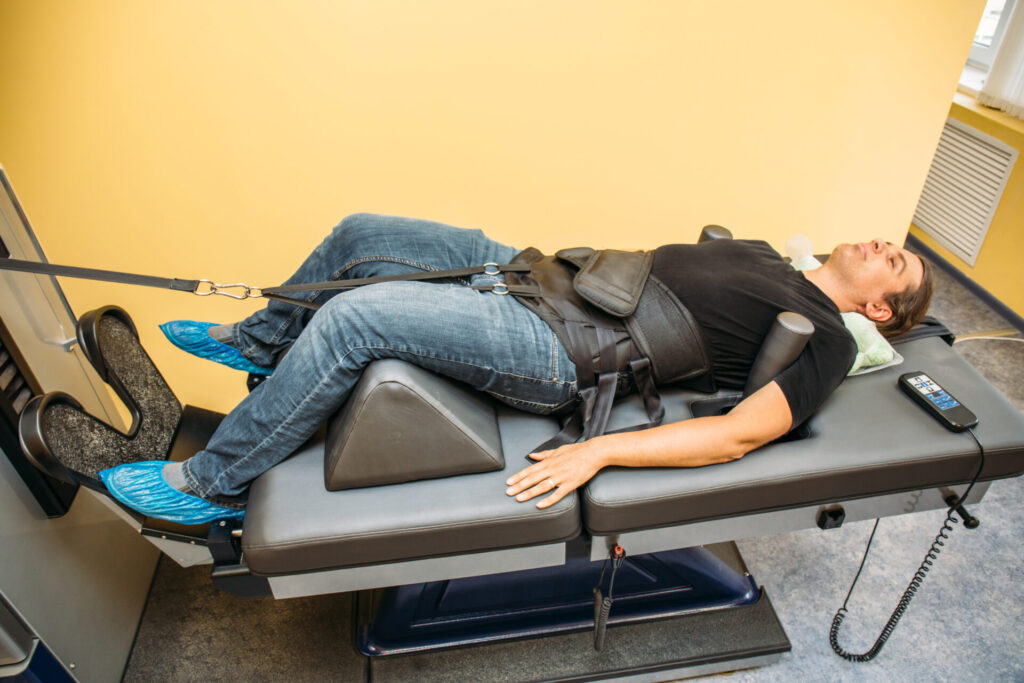This post may contain affiliate links, which means if you enroll through my link, I’ll receive a small commission at no extra cost to you.

If you’re considering spinal decompression therapy as a solution for your back pain, it’s crucial to understand not only the procedure itself but also the costs involved.
The landscape of medical treatments and their associated expenses has evolved. In this blog post, we’ll explore the ins and outs of spinal decompression therapy, and address the question, “how much does spinal decompression cost?” This will help you make an informed decision about your treatment options.
Key Takeaways
- Spinal Decompression Therapy is a treatment method designed to reduce pressure on the spine and relieve back pain.
- Costs of Non-Surgical Spinal Decompression range from $450-$6,000 while Surgical treatments can cost up to $100,000+.
- Consider all factors before making an informed decision about Spinal Decompression Therapy.
Understanding Spinal Decompression Therapy
Spinal decompression therapy is a treatment method designed to alleviate back pain by reducing pressure on the spine’s neural elements and relieve pressure on the spinal canal. Spinal decompression therapy targets conditions resulting from damage to the intervertebral discs, like herniated discs, bulging discs, and sciatica, offering relief and promoting healing. The therapy utilizes the concept of spinal traction, gently separating the vertebrae to alleviate discomfort and foster healing for bulging, degenerating, or herniated discs.
So, how does this therapy work? Spinal decompression therapy employs a computer-controlled table, also known as vertebral axial decompression, to delicately separate the vertebrae of the spine and reduce pressure in the discs. The primary goals of this traction and decompression therapy are to alleviate pain and create an ideal healing atmosphere for the affected discs. Generally, a patient will require 15-20 sessions over several weeks to achieve a positive outcome in spinal decompression therapy.
Types of Spinal Decompression Treatments
Spinal decompression treatments can be divided into two main categories: non-surgical and surgical options, depending on the severity of the condition. Non-surgical spinal decompression aims to stretch the spine to an appropriate degree to alter the positioning of the spinal disks while alleviating pressure from the spinal disc. On the other hand, surgical spinal decompression is a more aggressive approach, often utilized when other treatments have proven unsuccessful.
Patients who underwent surgery in clinical trials for spinal stenosis, which often involves the compression of nerve roots, showed a greater degree of improvement, including reduced leg pain, compared to those who received nonsurgical treatments. This indicates that surgery can be beneficial for patients with spinal stenosis.
Considering the available options and their success rates is a key factor in deciding the best course of action for your back pain treatment. The choice between non-surgical and surgical spinal decompression should be based on the severity of your condition, your overall health, and how well spinal decompression works for your individual needs.
Non-Surgical Spinal Decompression

Non-surgical spinal decompression is a type of electric traction that facilitates alleviating back pain by gently stretching the spine to relax the joints and reduce pressure on the spinal discs. During the procedure, the patient is fitted with a harness around their pelvis and trunk while remaining fully clothed. They are then positioned either face down or face up on a computer-controlled table, and the doctor operates the computer to customize the treatment to the patient’s needs. The treatment can take anywhere from 30-45 minutes. It may require up to 28 treatments over a 5-7 week period..
Non-surgical spinal decompression therapy is a less invasive alternative to surgery, offering pain relief and promoting healing without the risks associated with more aggressive procedures. However, be aware that certain individuals, like pregnant women and those with specific conditions, are advised against receiving non-surgical spinal decompression.
Surgical Spinal Decompression
Surgical spinal decompression therapy is a more invasive option, typically reserved for cases where other treatments have failed to provide relief. The surgical options for spinal decompression may range from:
- Minimally invasive techniques
- Laminectomy
- Discectomy
- Spinal fusion
The expected recovery time for surgical spinal decompression varies depending on the type of surgery performed. While surgical spinal decompression may provide more significant relief for some patients, it also carries a higher risk of complications and a longer recovery period than non-surgical alternatives.
Before opting for surgical spinal decompression therapy, carefully weigh the potential benefits and risks.
Cost Breakdown: Non-Surgical Spinal Decompression Therapy

Being aware of the associated spinal decompression cost is vital when considering non-surgical spinal decompression therapy. In 2024, the cost of non-surgical spinal decompression therapy can range from $45 to $200 per session, with total costs estimated between $450 to $6,000.
When deciding whether this treatment is the right choice for you, these expenses must be taken into account. Keep in mind that these costs can vary based on factors such as the provider, geographical location, and the number of sessions required.
You should discuss the costs with your healthcare provider and explore any potential financial assistance options.
Cost Breakdown: Surgical Spinal Decompression Therapy
Surgical spinal decompression therapy costs vary widely depending on the procedure, location, and surgeon, but can range from $15,000 to $100,000 or more. Keep in mind that insurance companies typically do not cover the cost of spinal decompression treatment. Therefore, patients seeking surgical spinal decompression therapy must be prepared for the significant financial burden that comes with this treatment option.
The cost of surgical spinal decompression therapy is dependent upon a number of factors, such as:
- The type of procedure
- The location of the procedure
- The experience of the surgeon
- The type of anesthesia utilized
Investigating all potential expenses and weighing the potential benefits against the costs is vital before committing to surgery.
Insurance Coverage and Out-of-Pocket Expenses
Insurance coverage for spinal decompression therapy is limited and may vary depending on the provider. Most insurance plans will cover part of the cost of the procedure, with the patient usually responsible for the remaining amount. Out-of-pocket expenses associated with spinal decompression therapy may include the cost of the procedure, any additional treatments or medications prescribed, and any follow-up visits.
To reduce out-of-pocket expenses, patients can explore their insurance coverage, compare prices, and inquire about payment plans or financial assistance from their provider. Especially when considering treatments with limited insurance coverage like spinal decompression therapy, proactive management of your healthcare expenses is crucial.
Factors Influencing Spinal Decompression Costs
Several factors may impact spinal decompression costs in 2024, including:
- Geographical location
- Treatment and procedure costs
- Patient factors
- Insurance coverage
- Provider fees
For instance, the cost of spinal decompression therapy in a rural area may be lower than in an urban area. Additionally, patient factors such as age, health condition, and lifestyle may affect the cost of spinal decompression therapy.
Understanding the various factors that influence the cost of spinal decompression therapy can help you make informed decisions about your treatment options. Discussing the potential expenses with your healthcare provider and exploring all available resources to manage the costs associated with spinal decompression therapy is important.
Comparing Costs with Other Treatment Options
In addition to spinal decompression therapy, other treatment options for addressing back pain and helping to relieve pain include:
- Physical therapy
- Acupuncture
- Chiropractic care
- Massage therapy
The cost of these alternative treatments may vary depending on the type of treatment and the service provider. Generally, spinal decompression is more costly than other treatment options, though it may be more effective in treating specific conditions.
Weighing the costs and benefits of spinal decompression therapy against other available treatment options is crucial to determining the best course of action for your needs. Consult with your doctor to explore all potential treatments and assess their effectiveness, side effects, and costs before making a decision.
Financial Assistance and Payment Plans
Financial assistance and payment plans may be available to help patients manage the costs of spinal decompression therapy. In 2024, there are several sources of financial assistance for spinal decompression therapy, including research grants from organizations such as the North American Spine Society (NASS) and funding opportunities for spinal cord injury (SCI) research. Some medical centers and hospitals may also offer financial assistance or payment plans for spinal decompression therapy.
To explore available financial aid and payment plan options, contact healthcare providers or research organizations for more information. Additionally, consider government programs, private insurance companies, and charitable organizations that may offer support for spinal decompression treatments.
Patient Reviews on Spinal Decompression Therapy
Patient reviews on spinal decompression therapy are mixed, with some reporting significant relief while others see little to no improvement. It has been reported that 75% to 89% of people undergoing spinal decompression therapy experience a significant improvement. However, individual experiences may vary, and it is essential to consider personal factors when evaluating the potential effectiveness of spinal decompression therapy for your specific situation.
Patient reviews can provide valuable insights into the real-world experiences of others who have undergone spinal decompression therapy but remember, every individual’s situation is unique. Consulting with your doctor and considering all available information is the best way to determine if spinal decompression therapy is the right choice for you.
Making an Informed Decision
Making an informed decision about spinal decompression therapy involves considering the following factors:
- Costs
- Potential benefits
- Risks
- Alternative treatment options
Adopting a “stepped” approach to spinal decompression procedures, beginning with less invasive and cost-efficient methods to evaluate the injury’s response, and progressing to surgery if necessary, can help in making the best decision for your individual needs.
Evaluate all available treatment options, assessing the costs, effectiveness, and side effects associated with each. Consult with your doctor to determine the most suitable treatment option for your individual needs and financial situation.
Taking the time to research and understand all aspects of spinal decompression therapy and its costs will better equip you to make an informed decision about your healthcare.
Summary
In conclusion, understanding the costs and factors associated with spinal decompression therapy is essential for making informed decisions about your back pain treatment options. While spinal decompression therapy can provide relief for many patients, it’s crucial to weigh the potential benefits, risks, and costs against alternative treatment options. By considering all available information and consulting with your doctor, you can make the best decision for your health and financial well-being.
Frequently Asked Questions

Why is spinal decompression so expensive?
Spinal decompression therapy can be expensive due to its costly equipment and lack of insurance coverage. This time-consuming therapy also typically requires four visits per week, adding to the overall cost.
How much are the decompression sessions?
Spinal decompression sessions typically cost around $3,500 for a full course of sessions on the DRX9000, however neither Medicare nor insurance companies typically cover the cost due to a lack of proof that it works.
How many sessions for spinal decompression?
Spinal decompression typically requires 12-20 sessions over a four to six week period, with appointments taking place 2-5 times per week.
What does a spinal decompression do?
Spinal decompression gently stretches the spine and changes the force and position, which helps bulging or herniated discs return to their correct locations. This decreases pressure on the spinal disks, allowing bulges or herniations to be pulled back into the disc and rehydrating the disc for pain relief.
What is the difference between non-surgical and surgical spinal decompression therapy?
Non-surgical spinal decompression therapy is a non-invasive procedure using electric traction to stretch the spine, while surgical decompression involves more invasive procedures for alleviating pain.
Living Healthy? Here’s a Healthcare Option That Aligns with Your Lifestyle! ??♀️

Ever heard of a Health Share? It’s a refreshing approach to healthcare that aligns with those leading a conscious, healthy lifestyle.
? What is a Health Share? At its core, a Health Share is a community of individuals who come together to share medical expenses. Instead of paying premiums, members contribute a monthly share, which is pooled together to support each other’s healthcare needs.
? How Does It Work?
- Monthly Sharing Amount: Think of it like a community pot. Each month, members contribute an amount, which is set aside for medical needs.
- Medical Need Submission: Got a medical expense? Submit it to the Health Share community.
- Bill Sharing: After assessing the need, funds are disbursed to address the medical costs, ensuring that members are supported in times of need.
? Why It’s a Win for Healthy Lifestylers?
- Aligned Values: Many Health Share communities emphasize preventative care and holistic health.
- Cost Efficiency: Typically, those leading a healthy lifestyle might find better savings here than with traditional insurance.
- Genuine Community: Be part of a group that cheers on your health journey and supports you when you need it most.
Ready to make the switch and align your health values with your healthcare approach? Dive into the world of Health Shares and find the perfect fit for your lifestyle.
? Ready to discover more about how Health Share Plans can complement your healthy lifestyle? Dive deep and make an informed choice here.
Health shares are not insurance and do not offer insurance coverage. Membership in a health share does not guarantee the payment or reimbursement of medical expenses. Each organization operates under its own membership guidelines, which determine what expenses may be eligible for sharing. This publication is for informational purposes only and is not provided by an insurance company. For state-specific notices and full program details, please visit the respective health share’s official website.





Leave a Reply